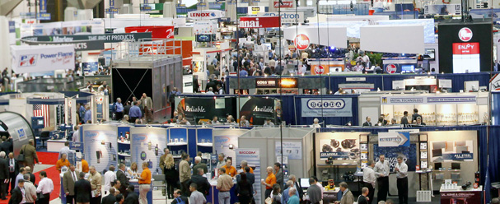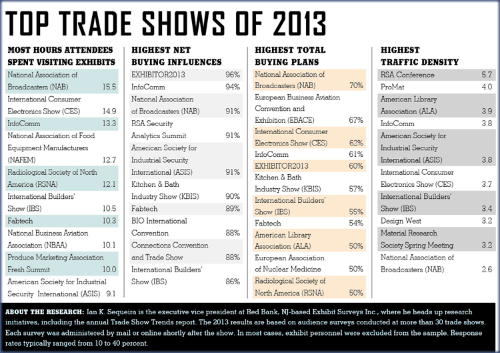The tradeshow, as old as merchant capitalism itself, is a premier branding event for each exhibitor — if staged and managed correctly. If not, it’s an expensive circus.
In no other venue is the importance of being unique more obvious.
Obvious to whom? The attendee, the customer — of course. Discerning one carnival barker from the next, while walking the exhibition floor, can be overwhelming, mind-numbing work for the customer. It shouldn’t be.

Judging, however, by the rows of near-identical booths and pitches, the need to rise above the white noise of me-too competition isn’t so evident to the exhibitors, the vendors. No matter how many tradeshows I attend — including the one I ran back in the ’90s — this doesn’t change. That’s because most companies and tradeshows are product-focused.
Newsflash: Unless purchasing paperclips and copier paper (commodities), customers buy value and solutions — not products. A huge disconnect.
It Should Be Easy
Customers are not your employees. Never treat them as such. They don’t work for you! Locating, grasping, and purchasing from your company shouldn’t be work — it should be easy — especially on the exhibit floor. Otherwise, your cost of sales skyrockets, as does their ire.
The tradeshow is a palpable, fathomable microcosm of the general marketplace, which is harder for vendors to comprehend. Ironically, many believed the advent of the Internet would render tradeshows irrelevant and obsolete. Didn’t happen. People like to socialize and learn from human experiences — impossible in cyberspace.
On the exhibit floor, real customers stare you in the face. They reveal their needs, wants, warts, and areas of confusion. With social media, you meet nobody and never know what is real. Worse, people on social media tend to be passive and easily offended. The tradeshow offers a huge opportunity to articulate and validate your brand to willing buyers.
Why Should They Visit Your Booth?
There are two levels of tradeshow branding:
- Event
- Exhibitor.
As the exhibitor, assume the event producer will use generic jargon to attract the crowd. But, both before and during the event, you must promote your unique value, your brand (sorry, jargon doesn’t sell) — to attract the most highly qualified attendees to your booth.
Attendees, most of whom travel long distances to top tradeshows, are there to solve big problems. If your brand (value proposition) doesn’t address those problems, in customer language (not vendor language), why should they visit your booth to see your product?
You want customers to visit your booth by design, not randomly stumble into it by accident, because it speaks to them, resonates with them! Your brand matters.
The tabulation below lists the top-ten US tradeshows from 2013, all association-based — underscoring the old adage, birds of a feather flock together. This means each event will be homogeneous. It also means that standing out, as an exhibitor, will be a huge challenge.
Most exhibitors will succumb to the temptation to use industry jargon, to blend in, to imitate each other, in such a clubby atmosphere. Conquer that temptation. Always put yourself in the customer’s shoes. Make it easy to locate, grasp, and purchase from your company.

(Courtesy: Exhibitor Media Group/Exhibit Surveys, Inc.)
Parting Advice to CEOs
Every tradeshow in which your company participates will be a homogeneous gathering of competitors. This presents both an advantage and disadvantage:
- Disadvantage: your competitors will steal your oxygen and customers, who will have difficulty distinguishing one copycat competitor from the other;
- Advantage: you can meet with, and close, a lot of qualified buyers, in a short span of time, if your brand piques and resonates with them.
To maximize your ROI on travel, exhibition, and promotion costs, your company’s message at the event must be unique, compelling, and in customer language — regardless of booth size — so customers and reporters will react to, remember, and repeat that message.
Design your booth and all branding (signage, brochures, pitches) around the customer and the customer experience — not your company, product, or technology.
HINT: Saying that you have the smallest, cheapest, fastest product, using the latest and coolest technology, is not unique, compelling, or in customer language — and not branding.
Always put yourself in the customer’s shoes. Make it easy to locate, grasp, and purchase from your company.
Notice: the branding rules above are identical to those outside the tradeshow, in the real world. But, like a pressure cooker, the compressed environment of the exhibit hall validates them faster. Can your brand take the heat?
© 2015 Marc H. Rudov. All Rights Reserved.
About the Author

Marc Rudov is a branding advisor to CEOs,
producer of MarcRudovTV, and author of four books

